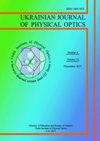Supervised regression modelling for mitigation of four-wave mixing in dense wavelength-division multiplexing systems
IF 8.6
4区 物理与天体物理
0 OPTICS
引用次数: 0
Abstract
A recent global crisis associated with COVID-19 has encouraged millions of people to work from home, thus causing a drastic increase in overall network traffic, data-rate requirements and end network capabilities This has also produced more noise, cross-talk and undesirable optical-fibre nonlinearities, especially a four-wave mixing (FWM) effect that deteriorates performance of dense wavelength-division multiplexing (DWDM) systems A presence of FWM in the DWDM systems imposes increasing complexity and latency of networks, and decreases their spectral efficiency In its turn, this degrades efficient utilization of optical bandwidth To mitigate the above problems, we suggest a supervised regression modelling (SRM) A relevant SRM-DWDM approach performs self-parametric optimization of the DWDM systems with machine-learning techniques and finds real trade-offs among various factors that affect the FWM Our model reduces complexity of modelling and computational time, resulting in accurate and reliable prediction of parameter values We also evaluate the performance of our SRM-DWDM technique by comparing its data with the iterative results obtained for different parameters (e g , output signal-to-noise ratio, Q-factor, signal power and noise power) Finally, we specify the procedures necessary for global optimization of DWDM systems © 2021, Institute of Physical Optics All rights reserved稠密波分复用系统中缓解四波混频的监督回归模型
最近与COVID-19相关的全球危机促使数百万人在家工作,从而导致整体网络流量、数据速率要求和终端网络功能急剧增加,这也产生了更多的噪音、串扰和不受欢迎的光纤非线性。特别是四波混频(FWM)效应,使密集波分复用(DWDM)系统的性能恶化。在DWDM系统中,FWM的存在增加了网络的复杂性和延迟,降低了它们的频谱效率,从而降低了光带宽的有效利用。我们建议使用监督回归建模(SRM)。一种相关的SRM-DWDM方法使用机器学习技术对DWDM系统进行自参数优化,并在影响FWM的各种因素之间找到真正的权衡。我们还通过将SRM-DWDM技术的数据与不同参数(如输出信噪比、q因子、信号功率和噪声功率)的迭代结果进行比较来评估其性能。最后,我们详细说明了DWDM系统全局优化所需的步骤©2021,Institute of Physical Optics版权所有
本文章由计算机程序翻译,如有差异,请以英文原文为准。
求助全文
约1分钟内获得全文
求助全文
来源期刊
CiteScore
9.90
自引率
0.00%
发文量
20
审稿时长
>12 weeks
期刊介绍:
“Ukrainian Journal of Physical Optics” contains original and review articles in the fields of crystal optics, piezo-, electro-, magneto- and acoustooptics, optical properties of solids and liquids in the course of phase transitions, nonlinear optics, holography, singular optics, laser physics, spectroscopy, biooptics, physical principles of operation of optoelectronic devices and systems, which need rapid publication.
The journal was founded in 2000 by the Institute of Physical Optics of the Ministry of Education and Science of Ukraine.

 求助内容:
求助内容: 应助结果提醒方式:
应助结果提醒方式:


